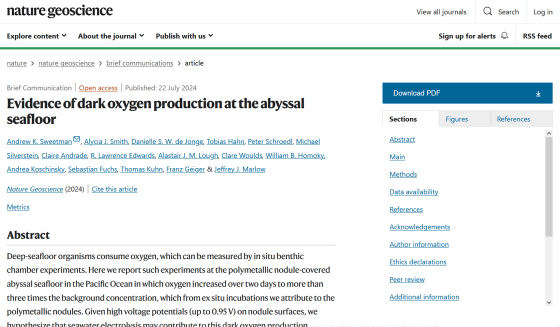It has been discovered that 'dark oxygen' is produced in the deep sea where no light reaches, raising new questions about the origin of oxygen-consuming organisms

Oxygen, essential for the survival of animals and plants, is thought to be produced by the photosynthesis of plants and phytoplankton. However, the existence of 'dark oxygen' produced in the deep sea, where no light reaches and photosynthesis is supposedly impossible, has been revealed, suggesting the possibility that oxygen may also be produced by things other than living organisms.
Evidence of dark oxygen production at the abyssal seafloor | Nature Geoscience
https://www.nature.com/articles/s41561-024-01480-8

News - Deep-sea discovery calls into question origins of life — The Scottish Association for Marine Science
https://www.sams.ac.uk/news/sams-news-dark-oxygen-discovery.html
Deep-ocean floor produces its own oxygen | EurekAlert!
https://www.eurekalert.org/news-releases/1051740
Mysterious 'Dark Oxygen' Discovered at Bottom of Ocean Stuns Scientists : ScienceAlert
https://www.sciencealert.com/mysterious-dark-oxygen-discovered-at-bottom-of-ocean-stuns-scientists
While surveying the ocean floor of the Clarion Clipperton area , located between Hawaii and the California Peninsula, a team led byAndrew Sweetman , a biogeochemist at the Scottish Association for Marine Science (SAMS), detected data suggesting that oxygen was being produced at depths of over 4,000 meters. However, since there was a common understanding that oxygen is only consumed in the deep ocean, where light does not reach, and is not newly produced, Sweetman's team thought that the equipment was broken.
'When we first got this data, we thought maybe the sensor had malfunctioned, because previous deep-sea studies had only seen oxygen being consumed, not produced,' Sweetman said.
Even after recalibrating the sensor, the strange oxygen readings continued for over a decade, so the team used a different sensor, but got the same results. Finally, the team was convinced that they had some groundbreaking, unprecedented data. Thus, full-scale research into the 'dark oxygen' produced in the deep sea began.

In the summer of 2023, Sweetman contacted
To test this hypothesis, the team sent several pounds of polymetallic nodules (manganese nodules) collected from the ocean floor to Geiger's lab. Polymetallic nodules are spherical masses found in the deep ocean, with layers of iron hydroxide and manganese hydroxide around the core. They contain metals such as cobalt, nickel, copper, lithium, and manganese, and several companies are working to extract these elements from the nodules.
In their experiments, the team confirmed that a single polymetallic nodule can generate a maximum voltage of 0.95 volts on its surface. The 1.5 volts needed to produce oxygen from seawater through electrolysis is easily achievable if multiple polymetallic nodules are clustered together like a series battery.
The photo below shows how polymetallic nodules actually collected from the ocean floor are immersed in simulated seawater and the amount of electricity they generate is being measured. 'It appears we have found a natural 'geobattery,'' Geiger said. 'This geobattery may be the basis for explaining the generation of dark oxygen in the ocean.'

by Franz Geiger/Northwestern University
There's still a lot to be investigated, such as the scale of dark oxygen production by polymetallic nodules, but the research team believes that 'the harvesting of polymetallic nodules from the seafloor to extract mineral resources may result in the creation of oxygen-poor ocean 'dead zones'.'
Geiger said, 'In 2016 and 2017, marine scientists visited sites where polymetallic nodules had been mined in the 1980s and found that not even bacteria had recovered in the mined areas, whereas marine life was thriving in unmined areas. It is not clear why such 'dead zones' persist for decades. However, the diversity of fauna in polymetallic nodule-rich seafloors is higher than that of tropical rainforests, so these findings raise serious concerns about mining strategies for seafloor resources.'
Sweetman also argues that the results of this study raise new questions about the origin of life on Earth: 'It was previously understood that aerobic organisms needed oxygen to emerge on Earth, and that the supply of oxygen on Earth began with photosynthetic organisms. But now we know that oxygen can be produced even in the lightless deep ocean. So we need to reconsider the question: Where did aerobic organisms originate?'
Related Posts:
in Science, Free Member, Posted by log1h_ik







